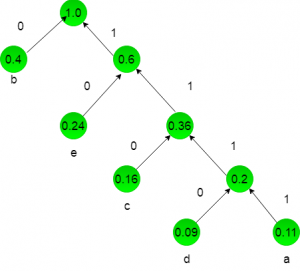PREVIOUS YEAR SOLVED PAPERS - November 2017 Paper 3
- Option : B
- Explanation : a = 0.11 b = 0.40 c = 0.16 d = 0.09 e = 0.24 we will draw a huffman tree:
 now huffman coding for character:
a = 1111, b = 0, c = 110, d = 1111, e = 10
lenghth for each character = no of bits * frequency of occurence:
a = 4 * 0.11 = 0.44
b = 1 * 0.4 = 0.4
c = 3 * 0.16 = 0.48
d = 4 * 0.09 = 0.36
e = 2 * 0.24 = 0.48
Now add these lenght for average length:
0.44 + 0.4 + 0.48 + 0.36 + 0.48 = 2.16
now huffman coding for character:
a = 1111, b = 0, c = 110, d = 1111, e = 10
lenghth for each character = no of bits * frequency of occurence:
a = 4 * 0.11 = 0.44
b = 1 * 0.4 = 0.4
c = 3 * 0.16 = 0.48
d = 4 * 0.09 = 0.36
e = 2 * 0.24 = 0.48
Now add these lenght for average length:
0.44 + 0.4 + 0.48 + 0.36 + 0.48 = 2.16



